holy cards
BARBARA CALAMARI & SANDRA DIPASQUA
FROM THE BIRTH OF CHRISTIANITY , saints have inspired the classic works of Western art. They are human representatives of divine grace, and their stories of faith and suffering, and trial and transcendence, have fascinated the secular and comforted, consoled, and encouraged believers. One of the most important and endearing traditions of Catholic iconography is that of the holy card. Offering images of the saints, these portable objects of daily ritual are carried for protection; given as remembrances at communions, confirmations, and funerals; and collected and traded.
With Holy Cards, authors Barbara Calamari and Sandra DiPasqua offer the first book to survey this rich and varied art form. Featuring a pantheon of major religious figures in Catholicism and many little-known saintssuch as St. Clare, the patron saint of television, and St. Monica, the patron saint of people with disappointing childrenthis book is sure to inform and inspire. The beautifully reproduced holy cards are arranged thematically, and each is accompanied by a brief biography of the subject, including attributes and powers. A glowing compendium of jewel-like images, Holy Cards can be treasured for both its spiritual and its artistic qualities. It is the perfect gift for those interested in Catholicism and devotional art.
H OLY C ARDS

Editor: Christopher Sweet
Designer: Sandra DiPasqua
Production Manager: Ankur Ghosh
The Library of Congress has cataloged the hardcover edition of this book as follows: Calamari, Barbara.
Holy cards/by Barbara Calamari & Sandra DiPasqua.
p. cm.
Includes bibliographical references and index.
ISBN 10: 0-8109-4338-7
1. Holy cards. 2. Printed ephemera. 3. Christian art and symbolismModern
period, 1500 I. DiPasqua, Sandra. II. Title.
NE958.C35 2004
76004482dc22
2003015832
Paperback ISBN: 978-1-4197-0227-3
Copyright 2004 Barbara Calamari and Sandra DiPasqua
Originally published in hardcover in 2004 by Abrams, an imprint of ABRAMS. This edition published in 2012. All rights reserved. No portion of this book may be reproduced, stored in a retrieval system, or transmitted in any form or by any means, mechanical, electronic, photocopying, recording, or otherwise, without written permission from the publisher.
Abrams books are available at special discounts when purchased in quantity for premiums and promotions as well as fundraising or educational use. Special editions can also be created to specification. For details, contact specialsales@abramsbooks.com or the address below.

115 West 18th Street
New York, NY 10011
www.abramsbooks.com
C ONTENTS

A CKNOWLEDGEMENTS Many thanks to our agent Jim Fitzgerald and our editor Christopher Sweet of Abrams Books, who made this project such a pleasure to work on. We were in touch with several holy card collectors who were very supportive in their communications with us, among them, Sister Mary Jacque Benner and Pierluigi Stradella. James Occhino lent us some real treasures from his family collection and Mr. Fred Pfefferlein of PekaVerlag kindly allowed us to use several of his companys beautiful images. Patricia Bates and Louis Turchioe are owed a special debt for their unconditional support. We are also grateful to Deborah Rust for her generosity and technical expertise. Brian Tully was a great help with his knowledge of Photoshop. Kate Castellucci and her devotion to St. Anthony deserves a special thank you.
The best thing about working on this project was the opportunity we had in meeting Father Eugene Carrella, Pastor of St. Adalberts Parish on Staten Island, New York. Father Carrella is not only one of the foremost collectors of holy cards in America, he is also someone who cared deeply enough about this project to assist us with research information as well as provide us with the majority of our images. Working with him has been an educational and thoroughly enjoyable experience.
Finally, we would like to dedicate this book to our parents, Virginia and Anthony DiPasqua and Leonora and Raymond Calamari.
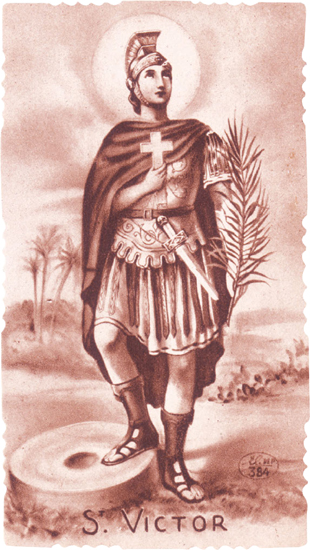
I NTRODUCTION The saints were human beings with human problems. They had bad marriages, debts, wayward children; they came from all walks of life. Yet through divine grace they were able to overcome their own personal obstacles and transcend the burdens of the material world. To Catholics they are an extended family that serve as a great inspiration in the ability of prayer and faith to change ones life. They have fascinating stories of suffering, failure, and victory, and many of us implore our favorite saints to pray with us and for us. They are not idols with magical powers, but they are mentors with whom we are able to identify. Since great art, architecture, and music are believed to be divinely inspired, visual art is an important element in Catholic religious expression. Frescoes in churches and stained glass windows traditionally served to instruct those who could not read. Images had to be designed to tell a story using objects, symbols, and colors that had their own significance. Many holy cards, besides being a visual physical portrait, also display the elements of a saints story or patronage.
The saints were human beings with human problems. They had bad marriages, debts, wayward children; they came from all walks of life. Yet through divine grace they were able to overcome their own personal obstacles and transcend the burdens of the material world. To Catholics they are an extended family that serve as a great inspiration in the ability of prayer and faith to change ones life. They have fascinating stories of suffering, failure, and victory, and many of us implore our favorite saints to pray with us and for us. They are not idols with magical powers, but they are mentors with whom we are able to identify. Since great art, architecture, and music are believed to be divinely inspired, visual art is an important element in Catholic religious expression. Frescoes in churches and stained glass windows traditionally served to instruct those who could not read. Images had to be designed to tell a story using objects, symbols, and colors that had their own significance. Many holy cards, besides being a visual physical portrait, also display the elements of a saints story or patronage.
This book does not contain every saint or every style of holy card. Some of the most popular saints are not here at all and the small amount of information given with each picture is there to help understand the image, not to tell the entire story of the saints life. There are many obscure saints here who are popular only in a few small towns or in religious communities. We have tried to put in different examples of the type of art available and have divided our chapter sections in a very basic way. Many saints could qualify for placement in several of these divisions. Cards that were created over 100 years ago have a different visual vocabulary than the more recent portrait-style cards. We found that the older cards were created using standard artists guides compiled in the Middle Ages for saints and their attributes. Having a knowledge of the meanings of the elements in these cards enables the image to be enjoyed on a deeper level. We have compiled lists of these elements, and in the back of this book is a bibliography where more complete lists can be found. We have interspersed cards that were popular a century ago with cards that are mass produced today. Though their artistic styles may vary widely, they have one thing in common: they were never considered precious art objects; they were meant to be carried and casually displayed, much like family photographs.
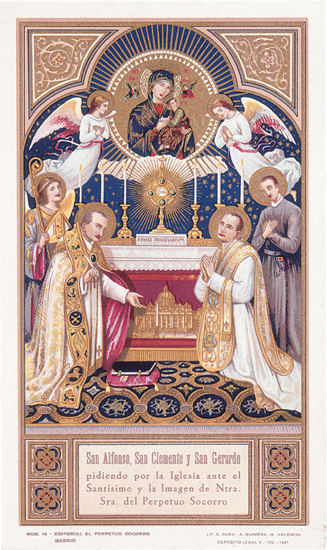
A B RIEF
H ISTORY
 It is not easy to tell an entire story in one still image, yet this is what holy cards attempt to do. They present a visual biography of a saints life. Inspired by paintings, these little portable images began as woodcut prints in the early fifteenth century. This process offered an inexpensive way for those unable to afford custom artworks to own an image of their patron saint. At that time in Europe, every village town and person was under the patronage of a saint. Having an image of ones saint was considered a form of protection. Handmade devotional cards utilized parchment, lace, and black ink-etched portraits. They were popular gifts, and our present-day lace Valentines Day cards are direct descendants of these early saints cards. In 1796 Aloys Senefelder invented lithography, a printing process which made the mass production of images possible. Soon after, the Benziger brothers developed a major business of printing religious images in Switzerland. With the advent of chromolithography these saints pictures could be printed in color. By the mid-nineteenth century Benziger was the foremost producer of Santini or little holy pictures. Local companies followed suit and each country developed its own distinct way of presenting a devotional image. In France, the area around the Church of San Sulpice became a major marketplace for religious goods. The San Sulpice holy cards are more sentimental and pastel toned. They have a painterly style, much like the French academic salon art of the late 1800s. Cards made in Belgium were created with more graphic color and sophisticated artistic styles. The wallpaper or background patterns have an Islamic influence. The subject matter is presented in a very enigmatic way, with the saints holding objects that are relevant to their stories. Swiss and German cards tend towards a fairy tale illustrative quality while Italian, Spanish, and Mexican cards are based on the presentation of the saints in fine art. When looking at these cards from a century ago, they are so exquisitely printed and manufactured that it is hard to believe that they were bought for pennies as little, disposable keepsakes.
It is not easy to tell an entire story in one still image, yet this is what holy cards attempt to do. They present a visual biography of a saints life. Inspired by paintings, these little portable images began as woodcut prints in the early fifteenth century. This process offered an inexpensive way for those unable to afford custom artworks to own an image of their patron saint. At that time in Europe, every village town and person was under the patronage of a saint. Having an image of ones saint was considered a form of protection. Handmade devotional cards utilized parchment, lace, and black ink-etched portraits. They were popular gifts, and our present-day lace Valentines Day cards are direct descendants of these early saints cards. In 1796 Aloys Senefelder invented lithography, a printing process which made the mass production of images possible. Soon after, the Benziger brothers developed a major business of printing religious images in Switzerland. With the advent of chromolithography these saints pictures could be printed in color. By the mid-nineteenth century Benziger was the foremost producer of Santini or little holy pictures. Local companies followed suit and each country developed its own distinct way of presenting a devotional image. In France, the area around the Church of San Sulpice became a major marketplace for religious goods. The San Sulpice holy cards are more sentimental and pastel toned. They have a painterly style, much like the French academic salon art of the late 1800s. Cards made in Belgium were created with more graphic color and sophisticated artistic styles. The wallpaper or background patterns have an Islamic influence. The subject matter is presented in a very enigmatic way, with the saints holding objects that are relevant to their stories. Swiss and German cards tend towards a fairy tale illustrative quality while Italian, Spanish, and Mexican cards are based on the presentation of the saints in fine art. When looking at these cards from a century ago, they are so exquisitely printed and manufactured that it is hard to believe that they were bought for pennies as little, disposable keepsakes.
Next page
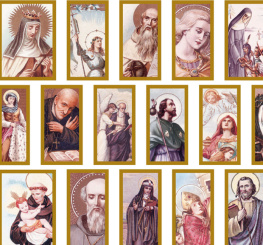

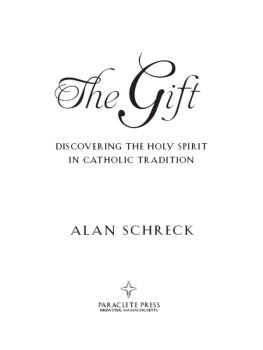


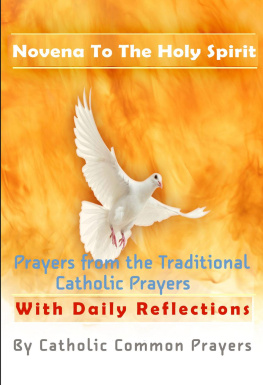








 The saints were human beings with human problems. They had bad marriages, debts, wayward children; they came from all walks of life. Yet through divine grace they were able to overcome their own personal obstacles and transcend the burdens of the material world. To Catholics they are an extended family that serve as a great inspiration in the ability of prayer and faith to change ones life. They have fascinating stories of suffering, failure, and victory, and many of us implore our favorite saints to pray with us and for us. They are not idols with magical powers, but they are mentors with whom we are able to identify. Since great art, architecture, and music are believed to be divinely inspired, visual art is an important element in Catholic religious expression. Frescoes in churches and stained glass windows traditionally served to instruct those who could not read. Images had to be designed to tell a story using objects, symbols, and colors that had their own significance. Many holy cards, besides being a visual physical portrait, also display the elements of a saints story or patronage.
The saints were human beings with human problems. They had bad marriages, debts, wayward children; they came from all walks of life. Yet through divine grace they were able to overcome their own personal obstacles and transcend the burdens of the material world. To Catholics they are an extended family that serve as a great inspiration in the ability of prayer and faith to change ones life. They have fascinating stories of suffering, failure, and victory, and many of us implore our favorite saints to pray with us and for us. They are not idols with magical powers, but they are mentors with whom we are able to identify. Since great art, architecture, and music are believed to be divinely inspired, visual art is an important element in Catholic religious expression. Frescoes in churches and stained glass windows traditionally served to instruct those who could not read. Images had to be designed to tell a story using objects, symbols, and colors that had their own significance. Many holy cards, besides being a visual physical portrait, also display the elements of a saints story or patronage.